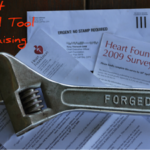Remember the Ice Bucket Challenge? It happened in the Summer of 2015 when the ALS Association in the US (and a number of related organizations around the world, where ALS is often called motor neurone disease) became the beneficiaries of a gargantuan fad. They raised more than $220 million worldwide.
By now, nearly two years later, it’s clear to almost everyone that trying to launch your own Ice Bucket Challenge is like trying to fund your organization by buying a winning lottery ticket. You could win — somebody has to! — but realistically … it’s not going to happen.
But here’s the good news: You can have Ice Bucket-like financial success. Yes, you. It doesn’t take lightning-strike luck. Just smart and well-targeted work. Quite a lot of work, actually. Which is why it’s rarely done. The field is wide open for you to be a hero at your organization!
You only need to do three things. Any one of the three will make a huge difference for you, but the more you do, the more astounding the amount of revenue you’ll see pouring in!
Here are the things to do (in no particular order):
Focus on planned (legacy) giving
There are a lot of checks with amounts that include a lot of zeroes waiting to be written to your organization. Some of them will just sort of drop out of the sky when donors decide on their own to leave you in their will.
But you’ll get a lot more of that if you actively cultivate it.
A lot more.
Really: A lot more.
How to cultivate planned giving is a bigger topic than fits in a blog post. But let’s just note that there are good and not-good ways to do it.
In fact, I’ve seen evidence that doing it, but doing it wrong, can actually drive away legacy givers!
So make sure you do it right.
The payoff for focusing on planned giving won’t be this summer. It’ll be five, ten, and more years from now. That’s another reason so many organizations don’t do this in any meaningful way. Why spend your time on something that’s going to pay off when you don’t work there anymore? (How about professional pride.)
Spend more time and money on your mid-value and major donors
Imagine a salesperson working at a Ferrari dealership who spent the same amount of time and effort on a customer wanting to buy a Ferrari key fob as he did on someone looking to buy an actual Ferrari. What would you think of that salesperson?
Does blooming idiot sound about right?
That’s exactly what a lot of fundraisers do. They treat all donors — whether they give $5 or $5,000 — exactly the same.
You could be just breaking even — or even losing money — on your low-end donors. The loss might be invisible, because the upper donors are more than picking up the slack, which makes the overall program look like it’s just fine.
You could make a lot more revenue if you spent (wasted) less on your low-end donors and more on your middle and major donors.
How should you be spending on them? Communicating with them more. More personal contact, like phone calls. Higher-end direct mail. More elaborate acknowledgments, thank-yous, and reporting back.
The result: More revenue, at a higher return on investment.
Also: Better retention of your best donors. And more upgrading.
The Ice Bucket-like impact of doing this is probably not as huge as a planned giving strategy. But it’s quicker.
Find more monthly donors
This may be the biggest opportunity of all. Monthly givers have an annual value that’s triple (or more) what typical donors give. And more important, a monthly donor’s retention is usually above 90% — compared to around 50% for most donors.
Between the high annual values and the superb retention rate, monthly donors are more than a nice-to-have. They’re an Ice Bucket.
How and where to get monthly donors is a big topic we’ll talk about another time. But you should be working on moving your donors into a monthly giving program. Just a few points that might help you do that:
- The main reason donors become monthly donors is their ease and convenience. (Not yours.)
- Push for EFT (direct debit) or credit card giving. (Note: EFT is a hard sell in the US. It’s much more common in the rest of the world.)
- Give the program a name that makes the donors feel like super-important insiders, heroes in the cause.
- Pursue these three goals — planned giving, middle and major donor giving, and monthly giving — with your donors, and you will have your own Ice Bucket-like astounding success.
Think of it as a “get rich slow” scheme.
Not everyone is willing to work for powerful results. That’s the main difference between you and the people who just keep whining that they can’t seem to get their own Ice Bucket Challenge!
Learn how to make your own Supporter Connection Survey by enrolling in Sean Triner’s online course that is available to all members of The Fundraisingology Lab.
This course is carefully structured to take you on a journey that takes you beyond learning. This is a hands-on course and at the end of the course, you will have produced your own Supporter Connection Survey!
Sean Triner, the supporter survey expert, takes you through creating a survey, step-by-step in four information packed modules. And there are plenty of bonus materials and videos that will turn you into a true expert on supporter connection surveys.
Join The Fundraisingology Lab here.
Jeff Brooks










